Evaluating Teaching Strategies: Equivalent Fractions Lesson Analysis
VerifiedAdded on 2023/01/11
|9
|2582
|61
Report
AI Summary
This report critically analyzes a primary school lesson on equivalent fractions. It evaluates the lesson's strengths, such as the use of building blocks to introduce the concept, and identifies weaknesses, including time constraints on student activities and the potentially demotivating closure activity. The report explores the theoretical underpinnings of the lesson, highlighting its connection to behavioral learning theory and the application of critical mathematical pedagogy. An alternative lesson strategy is proposed, emphasizing a cognitive approach that encourages student exploration, problem-solving, and individualized feedback, with justification based on cognitive learning theory and an improved mathematical pedagogy. The report concludes by advocating for the alternative plan's potential to enhance student understanding and engagement with the concept of equivalent fractions.

PRIMARY MATHEMATICS
AND NUMERACY
AND NUMERACY
Paraphrase This Document
Need a fresh take? Get an instant paraphrase of this document with our AI Paraphraser
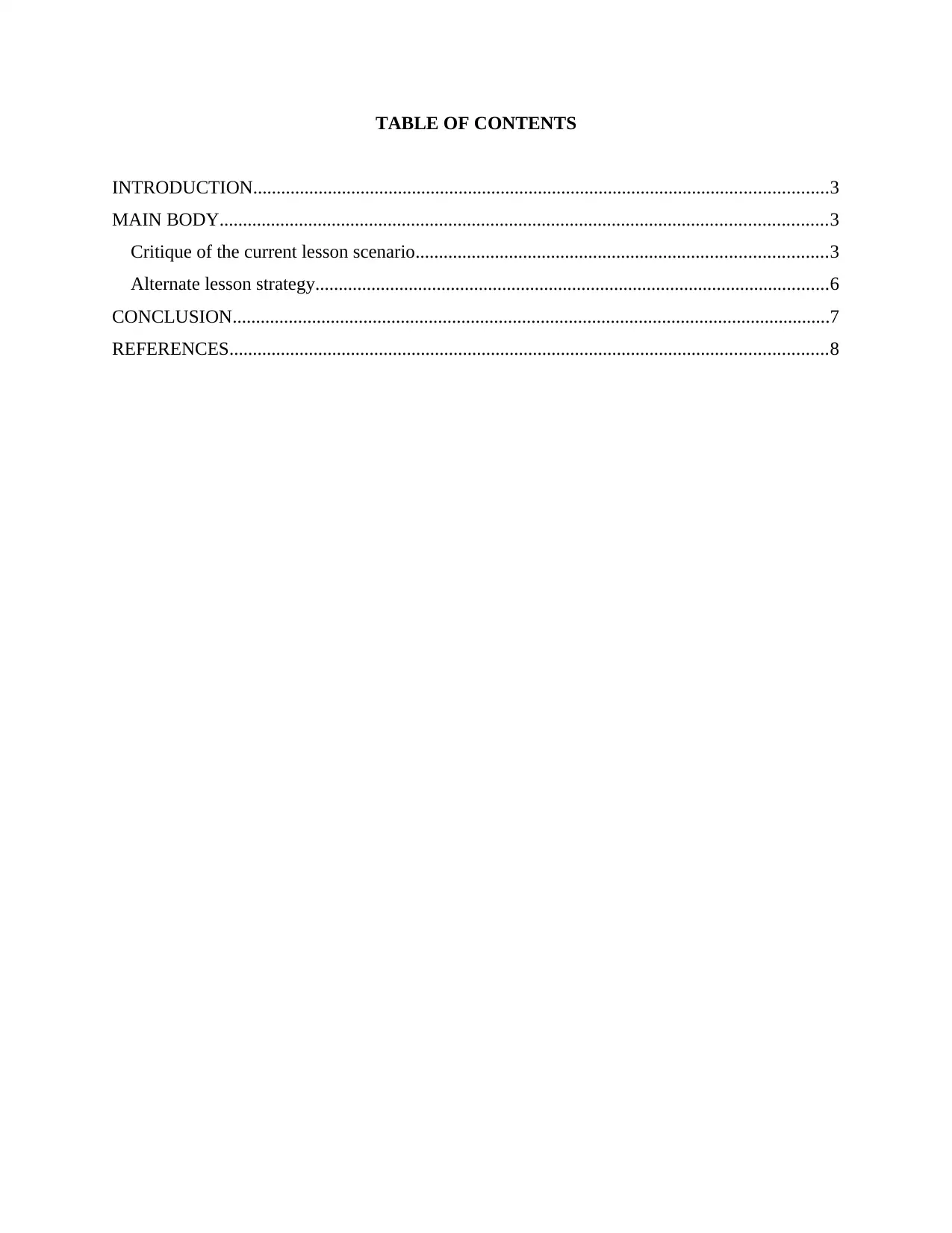
TABLE OF CONTENTS
INTRODUCTION...........................................................................................................................3
MAIN BODY..................................................................................................................................3
Critique of the current lesson scenario........................................................................................3
Alternate lesson strategy..............................................................................................................6
CONCLUSION................................................................................................................................7
REFERENCES................................................................................................................................8
INTRODUCTION...........................................................................................................................3
MAIN BODY..................................................................................................................................3
Critique of the current lesson scenario........................................................................................3
Alternate lesson strategy..............................................................................................................6
CONCLUSION................................................................................................................................7
REFERENCES................................................................................................................................8
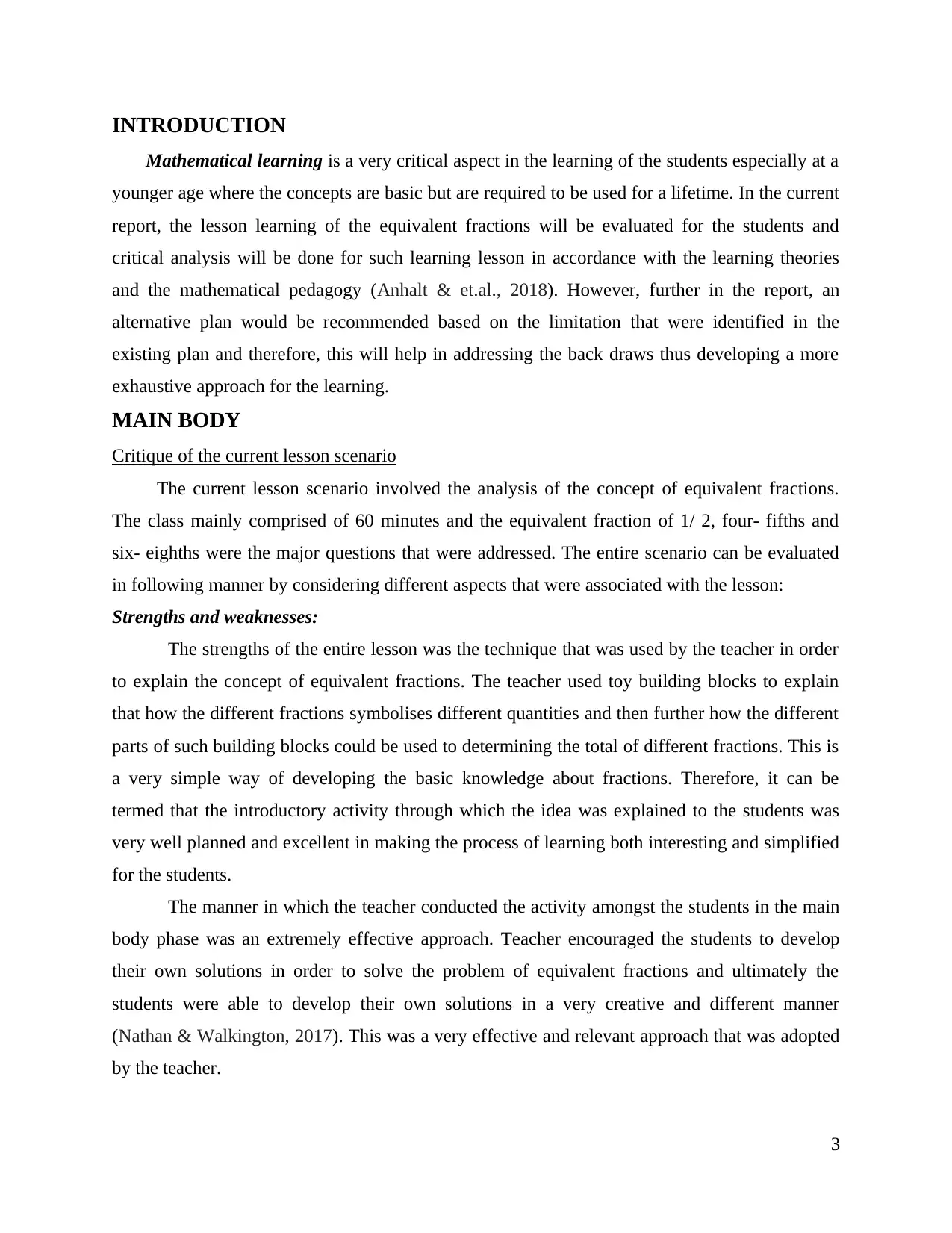
INTRODUCTION
Mathematical learning is a very critical aspect in the learning of the students especially at a
younger age where the concepts are basic but are required to be used for a lifetime. In the current
report, the lesson learning of the equivalent fractions will be evaluated for the students and
critical analysis will be done for such learning lesson in accordance with the learning theories
and the mathematical pedagogy (Anhalt & et.al., 2018). However, further in the report, an
alternative plan would be recommended based on the limitation that were identified in the
existing plan and therefore, this will help in addressing the back draws thus developing a more
exhaustive approach for the learning.
MAIN BODY
Critique of the current lesson scenario
The current lesson scenario involved the analysis of the concept of equivalent fractions.
The class mainly comprised of 60 minutes and the equivalent fraction of 1/ 2, four- fifths and
six- eighths were the major questions that were addressed. The entire scenario can be evaluated
in following manner by considering different aspects that were associated with the lesson:
Strengths and weaknesses:
The strengths of the entire lesson was the technique that was used by the teacher in order
to explain the concept of equivalent fractions. The teacher used toy building blocks to explain
that how the different fractions symbolises different quantities and then further how the different
parts of such building blocks could be used to determining the total of different fractions. This is
a very simple way of developing the basic knowledge about fractions. Therefore, it can be
termed that the introductory activity through which the idea was explained to the students was
very well planned and excellent in making the process of learning both interesting and simplified
for the students.
The manner in which the teacher conducted the activity amongst the students in the main
body phase was an extremely effective approach. Teacher encouraged the students to develop
their own solutions in order to solve the problem of equivalent fractions and ultimately the
students were able to develop their own solutions in a very creative and different manner
(Nathan & Walkington, 2017). This was a very effective and relevant approach that was adopted
by the teacher.
3
Mathematical learning is a very critical aspect in the learning of the students especially at a
younger age where the concepts are basic but are required to be used for a lifetime. In the current
report, the lesson learning of the equivalent fractions will be evaluated for the students and
critical analysis will be done for such learning lesson in accordance with the learning theories
and the mathematical pedagogy (Anhalt & et.al., 2018). However, further in the report, an
alternative plan would be recommended based on the limitation that were identified in the
existing plan and therefore, this will help in addressing the back draws thus developing a more
exhaustive approach for the learning.
MAIN BODY
Critique of the current lesson scenario
The current lesson scenario involved the analysis of the concept of equivalent fractions.
The class mainly comprised of 60 minutes and the equivalent fraction of 1/ 2, four- fifths and
six- eighths were the major questions that were addressed. The entire scenario can be evaluated
in following manner by considering different aspects that were associated with the lesson:
Strengths and weaknesses:
The strengths of the entire lesson was the technique that was used by the teacher in order
to explain the concept of equivalent fractions. The teacher used toy building blocks to explain
that how the different fractions symbolises different quantities and then further how the different
parts of such building blocks could be used to determining the total of different fractions. This is
a very simple way of developing the basic knowledge about fractions. Therefore, it can be
termed that the introductory activity through which the idea was explained to the students was
very well planned and excellent in making the process of learning both interesting and simplified
for the students.
The manner in which the teacher conducted the activity amongst the students in the main
body phase was an extremely effective approach. Teacher encouraged the students to develop
their own solutions in order to solve the problem of equivalent fractions and ultimately the
students were able to develop their own solutions in a very creative and different manner
(Nathan & Walkington, 2017). This was a very effective and relevant approach that was adopted
by the teacher.
3
⊘ This is a preview!⊘
Do you want full access?
Subscribe today to unlock all pages.

Trusted by 1+ million students worldwide

However, the main activity in which the students were involved was not very
comprehensive because the students are just at a learning stage and therefore it is necessary that
they are given adequate time to understand the concept and develop it firmly. Rather than
making it time restricted, the teacher should have given more time to certain students who
wanted to explore more on this activity. Now as a result of time bounded, the students simply
copied the solution that was presented by one or two students in the class and they could not
develop their minds to understand the concept of equivalent fractions and derive solutions on
their own (Chirinda & Barmby, 2017). Teacher should have made the activity time bound the
second time while teaching equivalent fractions so that once the concept has been clearly
established, students would have automatically worked on time aspect as well.
Lastly, the closure of the activity was also not very effective due to the fact that those
students who got more than 5 out of 10 questions were allowed for break but those who got
lower than this were asked to go to the teacher. This is not the correct method because this
induces biasness and lack of self worth in the child’s mind at a very young age. Additionally,
praising some students who did well in front of those students who were not very good
performers was also an extremely negative aspect.
Theoretical aspects of the lesson:
The mathematical thinking that was used by the teacher in the development of learning
was based on a theoretical manner where the behavioural theory of learning has been used. This
earning theory states that the child develops their learning on the basis of the lecture instructions
that they are receiving and by taking into consideration the surrounding behavioural aspects. This
type of learning theory is very effective in developing the child’s own mind where they
themselves formulate an understanding with the support of guide (Marsan, Bellomo & Gibelli,
2016). Rather than just imposing the concept on them, the children understand the concept that
they are being taught. This leads to the better formulation of concepts that last for life long and
help the students throughout their lives.
The mathematical thinking and process that is associated with the implementation of this
theory was that the teacher first explained the concept of equivalent fractions to the students and
then gave them the task which was to be completed by them on the basis of understanding that
they had developed (Cutler, 2016). This helped the students in developing their own
understanding reasoning. This was successful as well where one student derived the answer by
4
comprehensive because the students are just at a learning stage and therefore it is necessary that
they are given adequate time to understand the concept and develop it firmly. Rather than
making it time restricted, the teacher should have given more time to certain students who
wanted to explore more on this activity. Now as a result of time bounded, the students simply
copied the solution that was presented by one or two students in the class and they could not
develop their minds to understand the concept of equivalent fractions and derive solutions on
their own (Chirinda & Barmby, 2017). Teacher should have made the activity time bound the
second time while teaching equivalent fractions so that once the concept has been clearly
established, students would have automatically worked on time aspect as well.
Lastly, the closure of the activity was also not very effective due to the fact that those
students who got more than 5 out of 10 questions were allowed for break but those who got
lower than this were asked to go to the teacher. This is not the correct method because this
induces biasness and lack of self worth in the child’s mind at a very young age. Additionally,
praising some students who did well in front of those students who were not very good
performers was also an extremely negative aspect.
Theoretical aspects of the lesson:
The mathematical thinking that was used by the teacher in the development of learning
was based on a theoretical manner where the behavioural theory of learning has been used. This
earning theory states that the child develops their learning on the basis of the lecture instructions
that they are receiving and by taking into consideration the surrounding behavioural aspects. This
type of learning theory is very effective in developing the child’s own mind where they
themselves formulate an understanding with the support of guide (Marsan, Bellomo & Gibelli,
2016). Rather than just imposing the concept on them, the children understand the concept that
they are being taught. This leads to the better formulation of concepts that last for life long and
help the students throughout their lives.
The mathematical thinking and process that is associated with the implementation of this
theory was that the teacher first explained the concept of equivalent fractions to the students and
then gave them the task which was to be completed by them on the basis of understanding that
they had developed (Cutler, 2016). This helped the students in developing their own
understanding reasoning. This was successful as well where one student derived the answer by
4
Paraphrase This Document
Need a fresh take? Get an instant paraphrase of this document with our AI Paraphraser
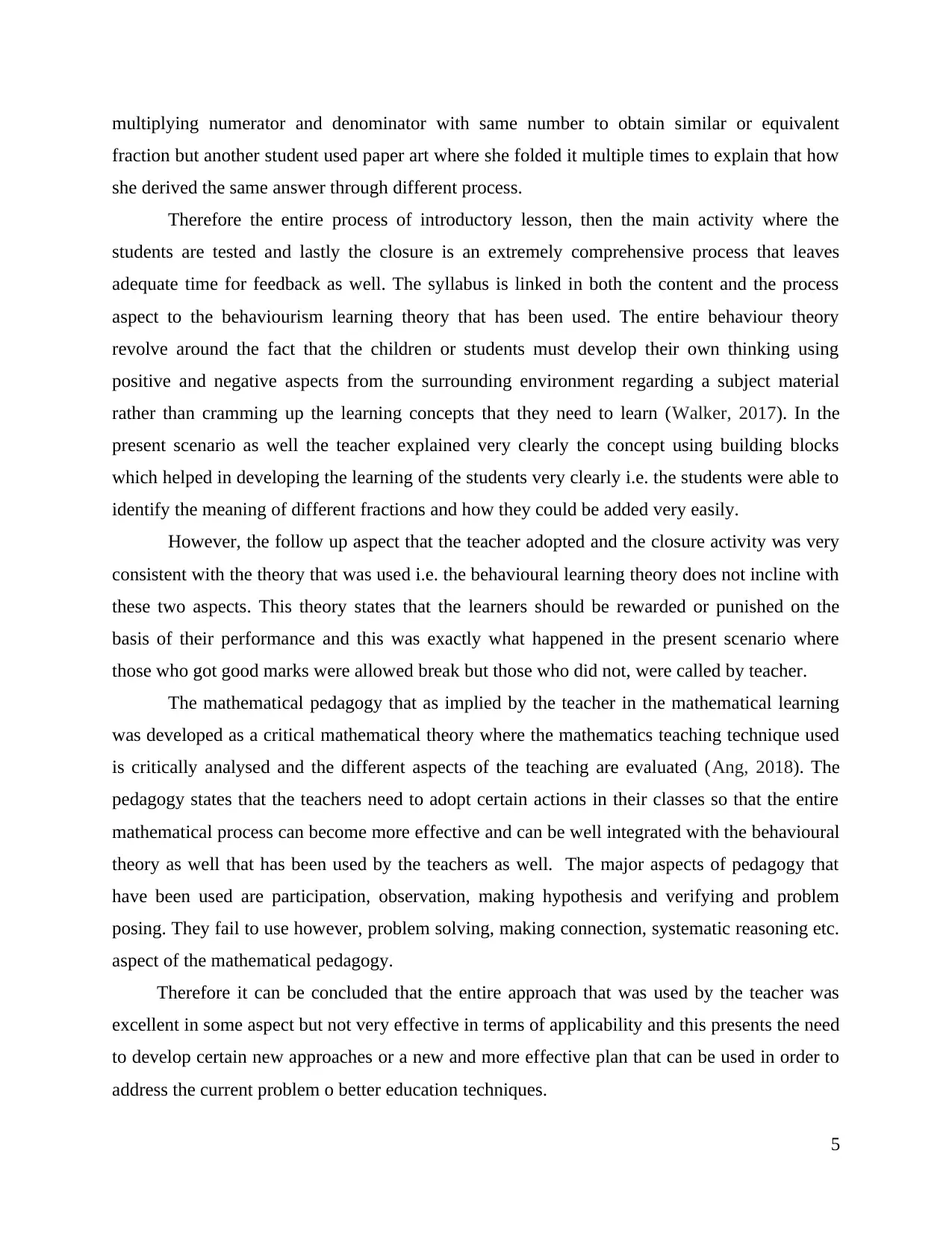
multiplying numerator and denominator with same number to obtain similar or equivalent
fraction but another student used paper art where she folded it multiple times to explain that how
she derived the same answer through different process.
Therefore the entire process of introductory lesson, then the main activity where the
students are tested and lastly the closure is an extremely comprehensive process that leaves
adequate time for feedback as well. The syllabus is linked in both the content and the process
aspect to the behaviourism learning theory that has been used. The entire behaviour theory
revolve around the fact that the children or students must develop their own thinking using
positive and negative aspects from the surrounding environment regarding a subject material
rather than cramming up the learning concepts that they need to learn (Walker, 2017). In the
present scenario as well the teacher explained very clearly the concept using building blocks
which helped in developing the learning of the students very clearly i.e. the students were able to
identify the meaning of different fractions and how they could be added very easily.
However, the follow up aspect that the teacher adopted and the closure activity was very
consistent with the theory that was used i.e. the behavioural learning theory does not incline with
these two aspects. This theory states that the learners should be rewarded or punished on the
basis of their performance and this was exactly what happened in the present scenario where
those who got good marks were allowed break but those who did not, were called by teacher.
The mathematical pedagogy that as implied by the teacher in the mathematical learning
was developed as a critical mathematical theory where the mathematics teaching technique used
is critically analysed and the different aspects of the teaching are evaluated (Ang, 2018). The
pedagogy states that the teachers need to adopt certain actions in their classes so that the entire
mathematical process can become more effective and can be well integrated with the behavioural
theory as well that has been used by the teachers as well. The major aspects of pedagogy that
have been used are participation, observation, making hypothesis and verifying and problem
posing. They fail to use however, problem solving, making connection, systematic reasoning etc.
aspect of the mathematical pedagogy.
Therefore it can be concluded that the entire approach that was used by the teacher was
excellent in some aspect but not very effective in terms of applicability and this presents the need
to develop certain new approaches or a new and more effective plan that can be used in order to
address the current problem o better education techniques.
5
fraction but another student used paper art where she folded it multiple times to explain that how
she derived the same answer through different process.
Therefore the entire process of introductory lesson, then the main activity where the
students are tested and lastly the closure is an extremely comprehensive process that leaves
adequate time for feedback as well. The syllabus is linked in both the content and the process
aspect to the behaviourism learning theory that has been used. The entire behaviour theory
revolve around the fact that the children or students must develop their own thinking using
positive and negative aspects from the surrounding environment regarding a subject material
rather than cramming up the learning concepts that they need to learn (Walker, 2017). In the
present scenario as well the teacher explained very clearly the concept using building blocks
which helped in developing the learning of the students very clearly i.e. the students were able to
identify the meaning of different fractions and how they could be added very easily.
However, the follow up aspect that the teacher adopted and the closure activity was very
consistent with the theory that was used i.e. the behavioural learning theory does not incline with
these two aspects. This theory states that the learners should be rewarded or punished on the
basis of their performance and this was exactly what happened in the present scenario where
those who got good marks were allowed break but those who did not, were called by teacher.
The mathematical pedagogy that as implied by the teacher in the mathematical learning
was developed as a critical mathematical theory where the mathematics teaching technique used
is critically analysed and the different aspects of the teaching are evaluated (Ang, 2018). The
pedagogy states that the teachers need to adopt certain actions in their classes so that the entire
mathematical process can become more effective and can be well integrated with the behavioural
theory as well that has been used by the teachers as well. The major aspects of pedagogy that
have been used are participation, observation, making hypothesis and verifying and problem
posing. They fail to use however, problem solving, making connection, systematic reasoning etc.
aspect of the mathematical pedagogy.
Therefore it can be concluded that the entire approach that was used by the teacher was
excellent in some aspect but not very effective in terms of applicability and this presents the need
to develop certain new approaches or a new and more effective plan that can be used in order to
address the current problem o better education techniques.
5
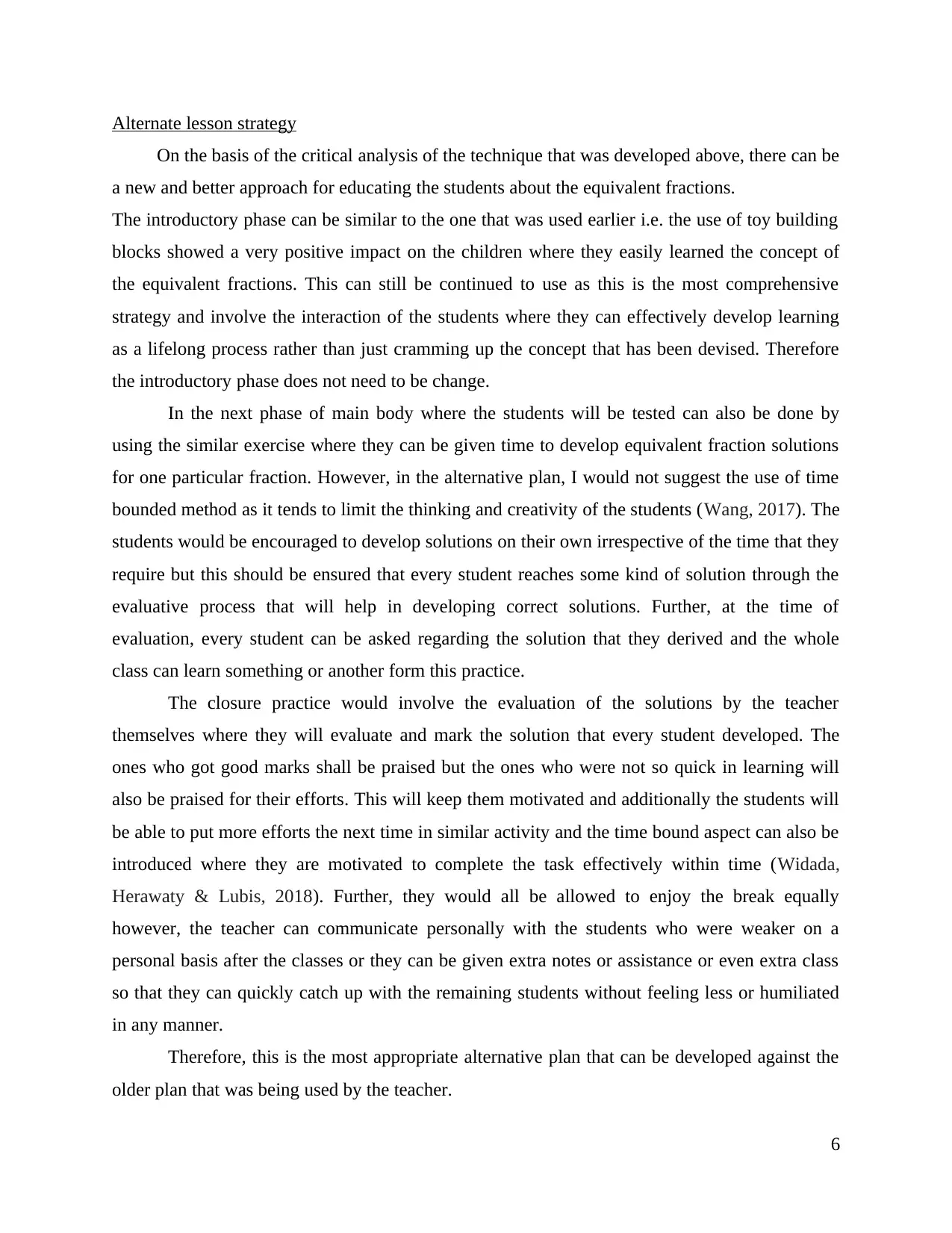
Alternate lesson strategy
On the basis of the critical analysis of the technique that was developed above, there can be
a new and better approach for educating the students about the equivalent fractions.
The introductory phase can be similar to the one that was used earlier i.e. the use of toy building
blocks showed a very positive impact on the children where they easily learned the concept of
the equivalent fractions. This can still be continued to use as this is the most comprehensive
strategy and involve the interaction of the students where they can effectively develop learning
as a lifelong process rather than just cramming up the concept that has been devised. Therefore
the introductory phase does not need to be change.
In the next phase of main body where the students will be tested can also be done by
using the similar exercise where they can be given time to develop equivalent fraction solutions
for one particular fraction. However, in the alternative plan, I would not suggest the use of time
bounded method as it tends to limit the thinking and creativity of the students (Wang, 2017). The
students would be encouraged to develop solutions on their own irrespective of the time that they
require but this should be ensured that every student reaches some kind of solution through the
evaluative process that will help in developing correct solutions. Further, at the time of
evaluation, every student can be asked regarding the solution that they derived and the whole
class can learn something or another form this practice.
The closure practice would involve the evaluation of the solutions by the teacher
themselves where they will evaluate and mark the solution that every student developed. The
ones who got good marks shall be praised but the ones who were not so quick in learning will
also be praised for their efforts. This will keep them motivated and additionally the students will
be able to put more efforts the next time in similar activity and the time bound aspect can also be
introduced where they are motivated to complete the task effectively within time (Widada,
Herawaty & Lubis, 2018). Further, they would all be allowed to enjoy the break equally
however, the teacher can communicate personally with the students who were weaker on a
personal basis after the classes or they can be given extra notes or assistance or even extra class
so that they can quickly catch up with the remaining students without feeling less or humiliated
in any manner.
Therefore, this is the most appropriate alternative plan that can be developed against the
older plan that was being used by the teacher.
6
On the basis of the critical analysis of the technique that was developed above, there can be
a new and better approach for educating the students about the equivalent fractions.
The introductory phase can be similar to the one that was used earlier i.e. the use of toy building
blocks showed a very positive impact on the children where they easily learned the concept of
the equivalent fractions. This can still be continued to use as this is the most comprehensive
strategy and involve the interaction of the students where they can effectively develop learning
as a lifelong process rather than just cramming up the concept that has been devised. Therefore
the introductory phase does not need to be change.
In the next phase of main body where the students will be tested can also be done by
using the similar exercise where they can be given time to develop equivalent fraction solutions
for one particular fraction. However, in the alternative plan, I would not suggest the use of time
bounded method as it tends to limit the thinking and creativity of the students (Wang, 2017). The
students would be encouraged to develop solutions on their own irrespective of the time that they
require but this should be ensured that every student reaches some kind of solution through the
evaluative process that will help in developing correct solutions. Further, at the time of
evaluation, every student can be asked regarding the solution that they derived and the whole
class can learn something or another form this practice.
The closure practice would involve the evaluation of the solutions by the teacher
themselves where they will evaluate and mark the solution that every student developed. The
ones who got good marks shall be praised but the ones who were not so quick in learning will
also be praised for their efforts. This will keep them motivated and additionally the students will
be able to put more efforts the next time in similar activity and the time bound aspect can also be
introduced where they are motivated to complete the task effectively within time (Widada,
Herawaty & Lubis, 2018). Further, they would all be allowed to enjoy the break equally
however, the teacher can communicate personally with the students who were weaker on a
personal basis after the classes or they can be given extra notes or assistance or even extra class
so that they can quickly catch up with the remaining students without feeling less or humiliated
in any manner.
Therefore, this is the most appropriate alternative plan that can be developed against the
older plan that was being used by the teacher.
6
⊘ This is a preview!⊘
Do you want full access?
Subscribe today to unlock all pages.

Trusted by 1+ million students worldwide

Justification:
The above plan for the learning regarding equivalent fractions has been developed in
accordance with the cognitive theory that states that the realistic experience are very effective in
developing the learning of the student where they are not punished for positive or negative
results but are rather promoted to develop their own cognitive pathways that will help in
developing effective solutions and understanding the points where their performance was not
very good (Wilkinson & Klaes, 2017). Therefore, the entire alternative plan has been developed
in accordance with the cognitive theory that supports the learning of an individual rather than
demeaning through the process.
Since the major outcome of the equivalent fractions is that the students understand how to
use and implement equivalent fractions, through this proposed alternative plan, the students will
be able to identify the core concept that lies behind the equivalent fractions. They can learn
through the introductory lecture about the concepts and then this can be implemented using the
activity in which they will get the chance to develop their own solutions and therefore the
concepts can be developed for a lifelong for all the students of the class rather than some of the
limited students.
The mathematics pedagogy used in the alternative plan is more focused on the observation,
problem solving and making connection aspect apart from the use of simple mathematical
communication aspect and systematic reasoning aspect (Erickson, 2019). Therefore, it can be
justified than the present approach is better than the one that was developed and used earlier.
CONCLUSION
The research and analysis done in the report above helps in concluding that the learning of
the students should be based more on the cognitive learning approach rather than on the
behavioural theory that was being used earlier. The report also concluded that it is better to use
all the components of the mathematical pedagogy rather than a few selected ones so that the
entire process of imparting mathematical education becomes more simplified.
7
The above plan for the learning regarding equivalent fractions has been developed in
accordance with the cognitive theory that states that the realistic experience are very effective in
developing the learning of the student where they are not punished for positive or negative
results but are rather promoted to develop their own cognitive pathways that will help in
developing effective solutions and understanding the points where their performance was not
very good (Wilkinson & Klaes, 2017). Therefore, the entire alternative plan has been developed
in accordance with the cognitive theory that supports the learning of an individual rather than
demeaning through the process.
Since the major outcome of the equivalent fractions is that the students understand how to
use and implement equivalent fractions, through this proposed alternative plan, the students will
be able to identify the core concept that lies behind the equivalent fractions. They can learn
through the introductory lecture about the concepts and then this can be implemented using the
activity in which they will get the chance to develop their own solutions and therefore the
concepts can be developed for a lifelong for all the students of the class rather than some of the
limited students.
The mathematics pedagogy used in the alternative plan is more focused on the observation,
problem solving and making connection aspect apart from the use of simple mathematical
communication aspect and systematic reasoning aspect (Erickson, 2019). Therefore, it can be
justified than the present approach is better than the one that was developed and used earlier.
CONCLUSION
The research and analysis done in the report above helps in concluding that the learning of
the students should be based more on the cognitive learning approach rather than on the
behavioural theory that was being used earlier. The report also concluded that it is better to use
all the components of the mathematical pedagogy rather than a few selected ones so that the
entire process of imparting mathematical education becomes more simplified.
7
Paraphrase This Document
Need a fresh take? Get an instant paraphrase of this document with our AI Paraphraser
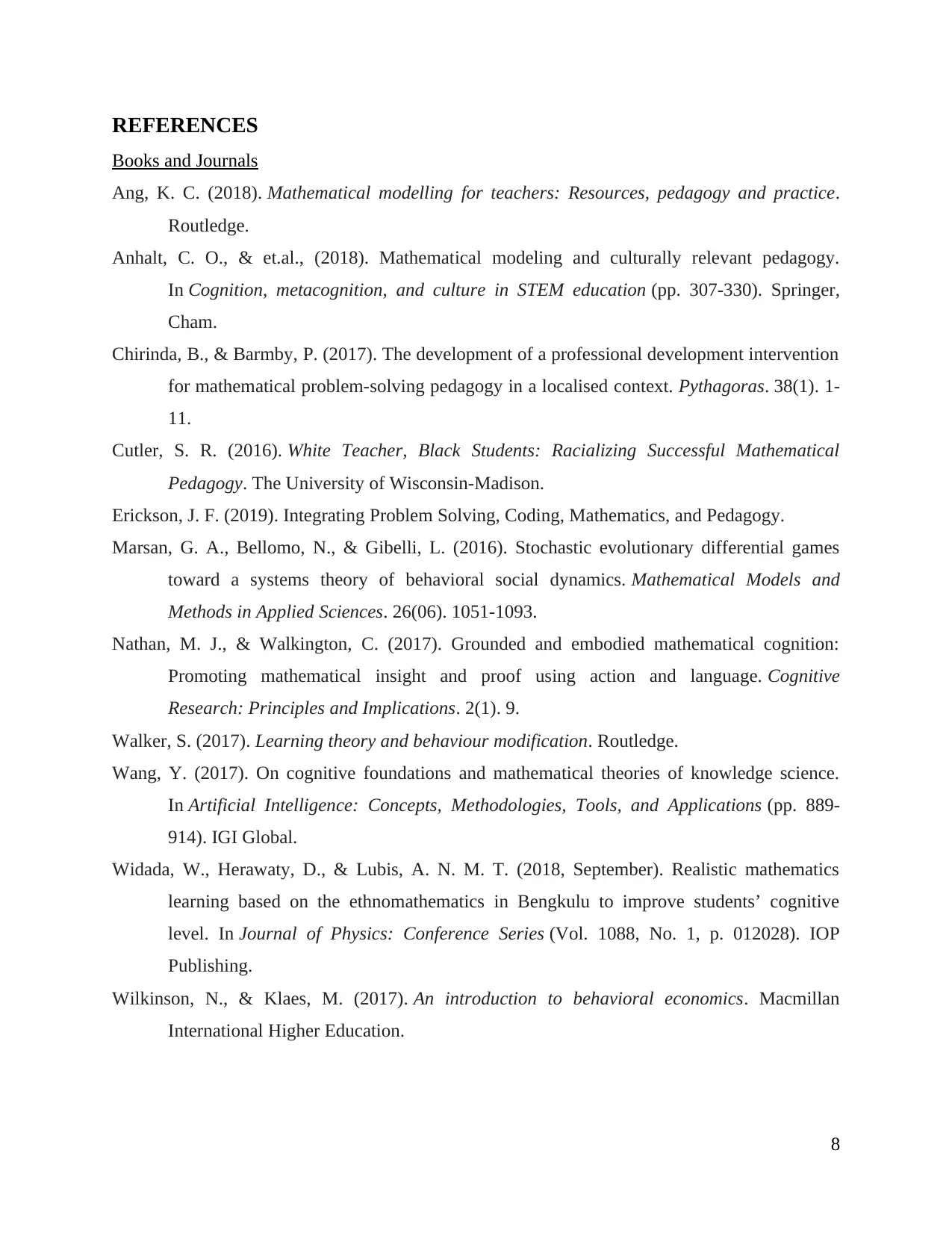
REFERENCES
Books and Journals
Ang, K. C. (2018). Mathematical modelling for teachers: Resources, pedagogy and practice.
Routledge.
Anhalt, C. O., & et.al., (2018). Mathematical modeling and culturally relevant pedagogy.
In Cognition, metacognition, and culture in STEM education (pp. 307-330). Springer,
Cham.
Chirinda, B., & Barmby, P. (2017). The development of a professional development intervention
for mathematical problem-solving pedagogy in a localised context. Pythagoras. 38(1). 1-
11.
Cutler, S. R. (2016). White Teacher, Black Students: Racializing Successful Mathematical
Pedagogy. The University of Wisconsin-Madison.
Erickson, J. F. (2019). Integrating Problem Solving, Coding, Mathematics, and Pedagogy.
Marsan, G. A., Bellomo, N., & Gibelli, L. (2016). Stochastic evolutionary differential games
toward a systems theory of behavioral social dynamics. Mathematical Models and
Methods in Applied Sciences. 26(06). 1051-1093.
Nathan, M. J., & Walkington, C. (2017). Grounded and embodied mathematical cognition:
Promoting mathematical insight and proof using action and language. Cognitive
Research: Principles and Implications. 2(1). 9.
Walker, S. (2017). Learning theory and behaviour modification. Routledge.
Wang, Y. (2017). On cognitive foundations and mathematical theories of knowledge science.
In Artificial Intelligence: Concepts, Methodologies, Tools, and Applications (pp. 889-
914). IGI Global.
Widada, W., Herawaty, D., & Lubis, A. N. M. T. (2018, September). Realistic mathematics
learning based on the ethnomathematics in Bengkulu to improve students’ cognitive
level. In Journal of Physics: Conference Series (Vol. 1088, No. 1, p. 012028). IOP
Publishing.
Wilkinson, N., & Klaes, M. (2017). An introduction to behavioral economics. Macmillan
International Higher Education.
8
Books and Journals
Ang, K. C. (2018). Mathematical modelling for teachers: Resources, pedagogy and practice.
Routledge.
Anhalt, C. O., & et.al., (2018). Mathematical modeling and culturally relevant pedagogy.
In Cognition, metacognition, and culture in STEM education (pp. 307-330). Springer,
Cham.
Chirinda, B., & Barmby, P. (2017). The development of a professional development intervention
for mathematical problem-solving pedagogy in a localised context. Pythagoras. 38(1). 1-
11.
Cutler, S. R. (2016). White Teacher, Black Students: Racializing Successful Mathematical
Pedagogy. The University of Wisconsin-Madison.
Erickson, J. F. (2019). Integrating Problem Solving, Coding, Mathematics, and Pedagogy.
Marsan, G. A., Bellomo, N., & Gibelli, L. (2016). Stochastic evolutionary differential games
toward a systems theory of behavioral social dynamics. Mathematical Models and
Methods in Applied Sciences. 26(06). 1051-1093.
Nathan, M. J., & Walkington, C. (2017). Grounded and embodied mathematical cognition:
Promoting mathematical insight and proof using action and language. Cognitive
Research: Principles and Implications. 2(1). 9.
Walker, S. (2017). Learning theory and behaviour modification. Routledge.
Wang, Y. (2017). On cognitive foundations and mathematical theories of knowledge science.
In Artificial Intelligence: Concepts, Methodologies, Tools, and Applications (pp. 889-
914). IGI Global.
Widada, W., Herawaty, D., & Lubis, A. N. M. T. (2018, September). Realistic mathematics
learning based on the ethnomathematics in Bengkulu to improve students’ cognitive
level. In Journal of Physics: Conference Series (Vol. 1088, No. 1, p. 012028). IOP
Publishing.
Wilkinson, N., & Klaes, M. (2017). An introduction to behavioral economics. Macmillan
International Higher Education.
8

9
⊘ This is a preview!⊘
Do you want full access?
Subscribe today to unlock all pages.

Trusted by 1+ million students worldwide
1 out of 9
Related Documents
Your All-in-One AI-Powered Toolkit for Academic Success.
+13062052269
info@desklib.com
Available 24*7 on WhatsApp / Email
![[object Object]](/_next/static/media/star-bottom.7253800d.svg)
Unlock your academic potential
Copyright © 2020–2025 A2Z Services. All Rights Reserved. Developed and managed by ZUCOL.





